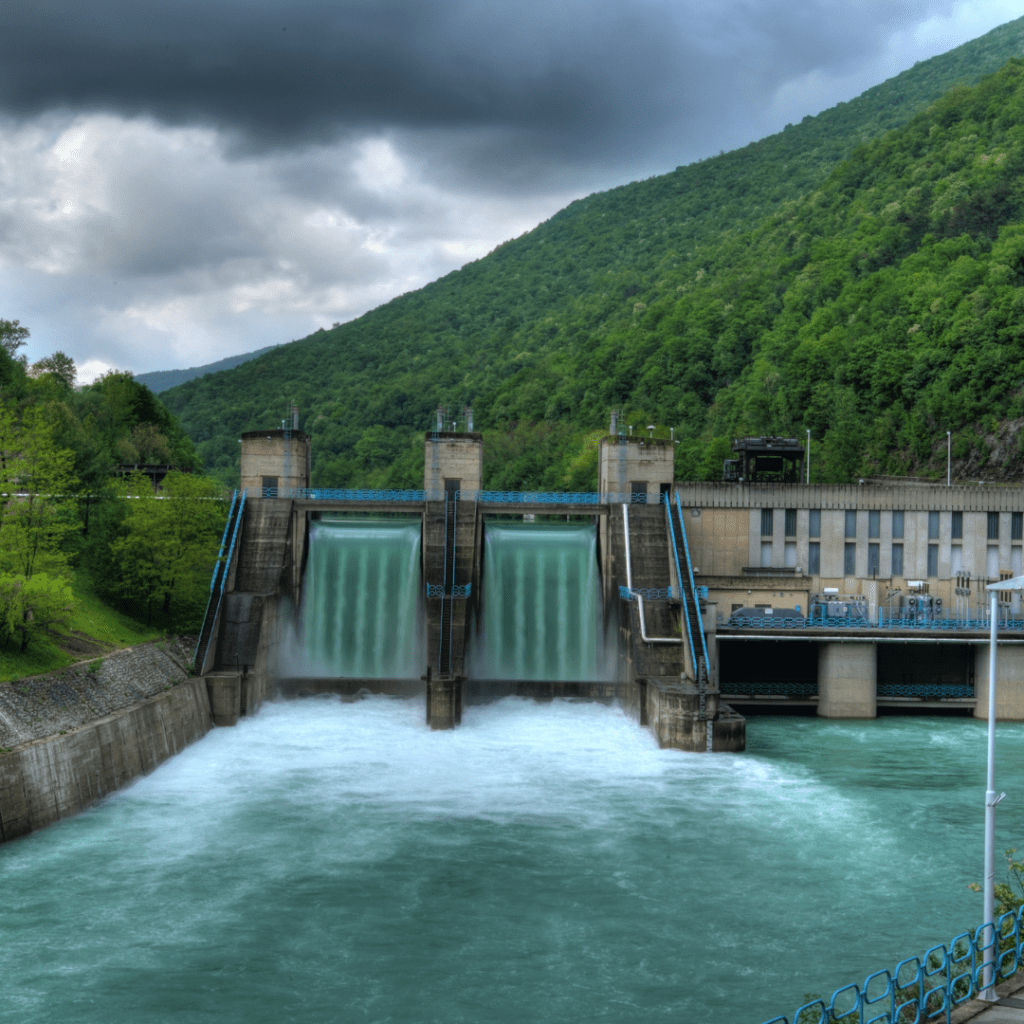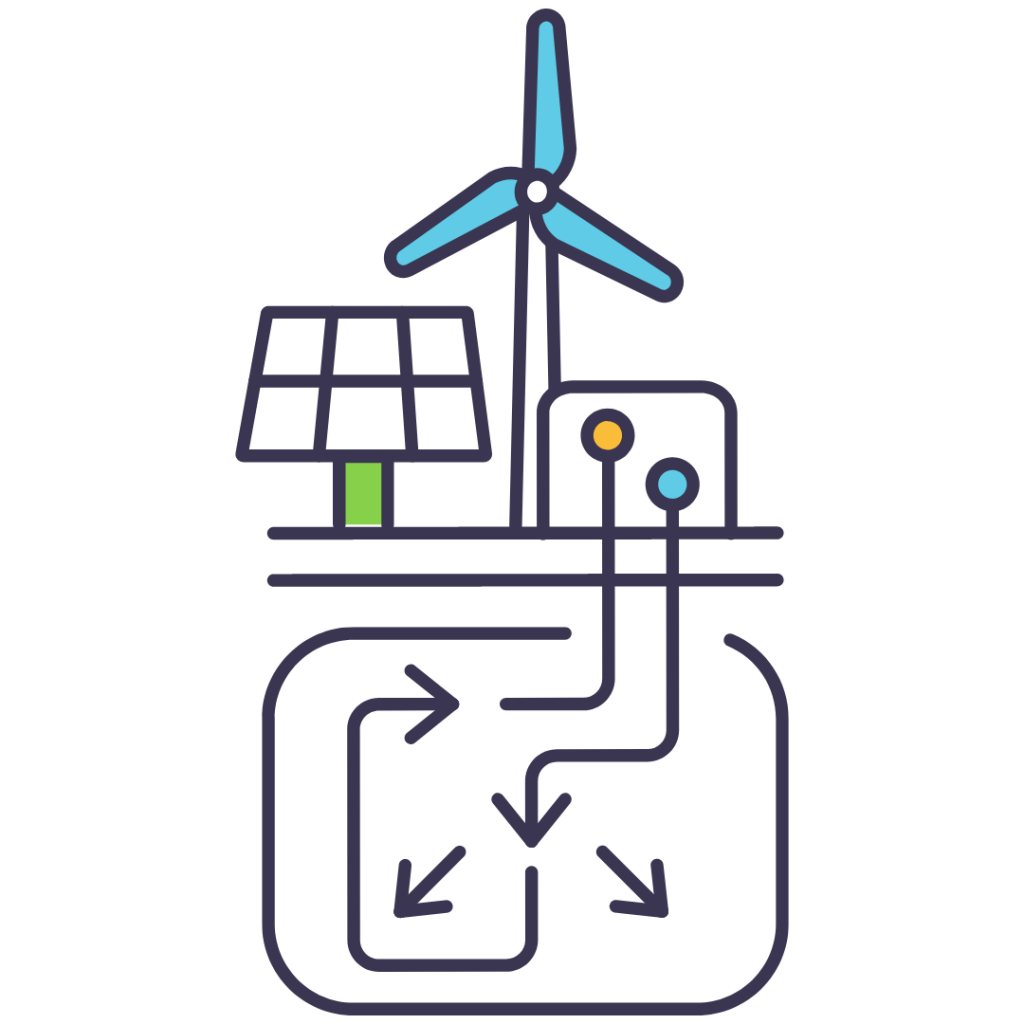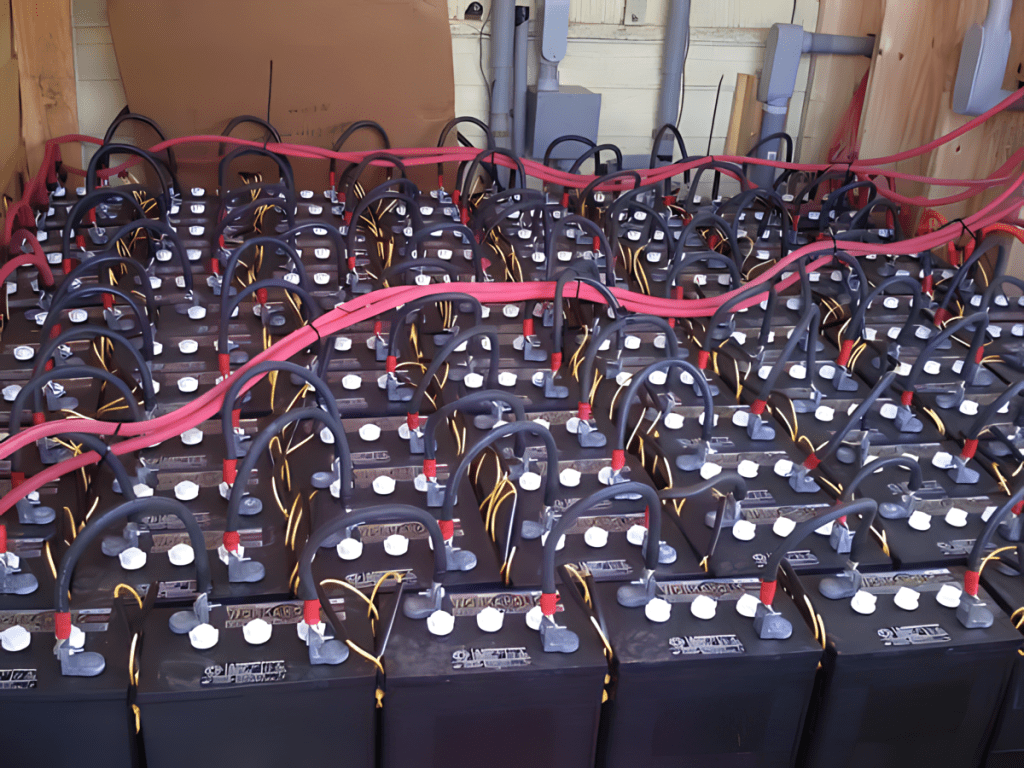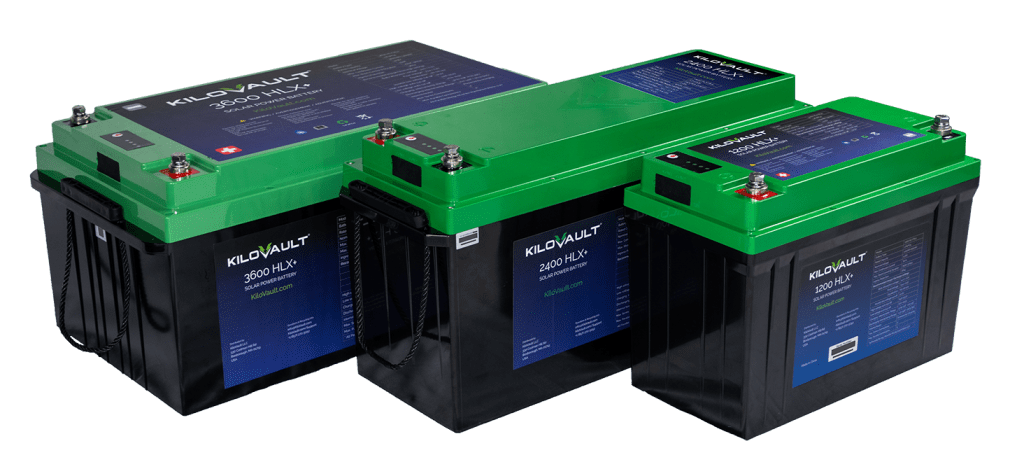

Energy storage technologies are becoming increasingly important in our current energy landscape. As the need for reliable, constant and renewable sources of energy grows, so too does the necessity of efficient energy storage solutions. Energy storage technologies are used to store electric power that can be generated from renewable sources such as solar and wind. This allows us to access clean, green energy even when our natural resources like wind and sun aren’t available. altE sells battery energy storage systems and hybrid systems that are most often paired with solar or wind renewable energy resources. However, in this article, let’s explore some of the leading non-battery based energy storage technologies for large scale applications as well as the top verities of battery energy storage.
Pumped Hydroelectric Storage

One of the most common forms of energy storage currently in use is pumped hydroelectric storage (PHS). PHS involves storing excess electricity from renewable sources by lifting water from one reservoir to another at a higher elevation. During times of peak electricity demand, the stored water is released back downhill toward a lower reservoir where it powers a turbine to produce electricity again. It’s an efficient and relatively inexpensive way to store excess electrical capacity so that it may be released during peak times when it’s needed most.
Compressed Air Energy Storage (CAES)

Another form of electricity storage requires temporarily storing air under pressure in underground caverns or tanks before releasing it back into an onsite turbine at periodical intervals when there is greater demand for power on the grid. Compressed air energy storage (CAES) systems allow utilities to maximize their existing infrastructure while providing additional services like peak shaving or load shifting − still making use existing assets but reducing stress during peak periods without having to build new plants − allowing utilities more operational efficiency while minimizing additional costs.
Flywheel Energy Storage

Unlike other forms of energy storage which rely on chemical reactions occurring within a battery system, flywheel technology works by using rotor blades spinning inside a vacuum. Flywheels offer much faster response rates compared conventional battery banks with no significant degradation over time. Residences rarely install flywheels since they can take substantial space.
Lead Acid Batteries

Lead-acid batteries are commonly used to store excess electricity because they have excellent density-to-weight ratios and they’re fairly easy to maintain as well. Lead-acid batteries typically consist of two electrodes – positive, which is made up of lead dioxide, and negative, composed of pure lead. These electrodes react with an electrolyte when electric charge is applied or removed from them resulting in energy being stored or released. Although these types of batteries may last for just a few years due to their short lifespan, advancements in technology have resulted in longer lasting options with greater overall efficiency than their predecessors. You can learn more about lead acid batteries in the altE Resource Library or see the Deep Cycle Solar Batteries we have for sale on our store.
Lithium-ion Batteries

Lithium ion batteries are increasingly being used for stationary energy storage as they offer high energy density and can provide large amounts of power in a relatively small space. They have superior life span compared to lead acid, making them a more cost-effective solution over the life of the project. Furthermore, their higher operating temperature range than other battery chemistries allows for more design flexibility when incorporating stationary energy storage into new or existing systems. Overall, lithium ion batteries provide an excellent option for stationary energy storage due to their unique characteristics, providing high efficiency and longer life cycles. You can read more about lithium ion batteries on our storage page, or by checking out our lithium based energy storage systems.
Tips on selecting the right energy storage technology for your project.
Today’s energy storage technology is advancing at an exponential rate. With more and more choices available, it can be difficult to decide which one is right for you. To help make your decision easier, here are some tips on selecting the right energy storage technology:
1. Understand Your Energy Needs.
Before you dive into selecting a particular energy storage technology, it’s important to have a clear understanding of what your needs are. Ask yourself questions such as: how much energy do I need stored? What duration of time do I need my energy stored for? What type of environment will the energy storage system be in? These all play a role in determining which type of energy storage technology is best for you. With these needs in mind, evaluate the size and duration of the charge/discharge cycle along with cost considerations, scalability, safety requirements, project location restrictions, and temperature requirements.
2. Evaluate the Different Energy Storage Technologies.
altE sells battery based energy storage systems and products for residential and commercial applications. Unless you are developing a large utility scale energy storage system, you will likely want to go with either lead acid or lithium ion batteries. If you are incorporating solar into the project, check our our solar batteries article in our Resource Library.
3. Consider Costs and Space Requirements.
If space is tight, lithium batteries will have a higher energy density, meaning more energy in the same amount of space. Lithium batteries will have a higher upfront cost then lead acid, but will last longer, giving them a lower total cost of ownership for the lifetime of the battery energy storage system. Lithium batteries also don’t require maintenance like lead acid batteries do. With lead acid, you’ll have a lower up front cost, but will need to have a dedicated maintenance regime and will need to replace the batteries more frequently. Read more about space requirements in our article “How to store solar batteries“.
4. Determine if Grid Interconnection is Needed.
Determining if grid interconnection is desired, required and feasible for a given structure or system can be a difficult process. This decision needs to take into account factors such as the electricity supply, infrastructure, local regulations, and economics of connecting to an existing grid. The cost and benefit associated with interconnecting will vary depending on these factors and so mapping out these considerations is a critical part of the decision-making process. Ultimately, the objective should be to provide reliable access to electricity at the lowest possible cost. The altE Resource Library can help provide more incite on if grid connected or off grid is right for you.
5. Research Local Incentives and Rebates for Energy Storage Systems.
A key part of buying an Energy Storage System is often exploring the many different incentives and rebates available from local, state and federal agencies. These can help to reduce the cost of installation and maintenance. Additionally, researching tax benefits for energy storage systems can aid with long-term planning as well as contribute to saving money in the short-term. Researching these incentives will ensure that you get the most out of investing in an Energy Storage System while also staying informed on upcoming changes or updates being implemented at a government level. The altE Solar Rebates and Renewable Energy Incentives page can help you in this process or you can check the Database of State Incentives for Renewables and Efficiency and the IRS FAQ for more details on state and federal incentive programs.
6. Choose to work with an installation Company or Do-It-Yourself.
When considering an energy storage upgrade to your home or business, you have the option of either doing it yourself or hiring a professional installation company. Hiring an installation company can save you time and money as they have the tools, expertise, and hardware to get the job done quickly and efficiently. However, if you’re a “do-it-yourselfer” then you may find this type of project more fun and rewarding. It requires patience however the biggest advantage is that it gives you more control over the entire process, from start to finish. At the end of the day, it’s up to you to decide whether working with an installation company or doing it yourself is more practical for you in terms of cost, efficiency, and personal satisfaction. If you decide to go the DIY route, altE is a one stop shop for all your products. In the event you want to work with an installer, give altE a call at 877-878-4060 and we’ll help you find a local installer in your area.
Frequently Asked Questions about battery energy storage
- What is battery storage?
Battery storage systems are advanced energy storage solutions that enable a variety of essential functions, from storing solar power from photovoltaic (PV) systems, to providing backup power in case of an outage. They convert solar energy into a form which is easy and convenient for end-users to access on demand. By combining solar panel technology with battery storage, users can benefit from the most efficient way to manage their energy consumption and save money in the long run. More specifically, battery storage assists in managing peak demand, provides backup power during grid outages, helps to balance energy costs, optimizes self-consumption of energy produced by the panels installed separately and allows users to take advantage of time-of-use rates adjustments.
- Why is battery storage important and what are its benefits?
Battery Storage is becoming increasingly important due to its multiple benefits, both in terms of the environment, and for businesses or homeowners. Battery storage helps transition our energy systems away from traditional power plants towards distributed renewable sources by allowing for the collection and preservation of excess electricity that can be used when needed. It enables a smooth transition to solar energy and helps reduce environmental pollution, as well as giving individuals autonomy over their own energy production, transmission and consumption. Moreover, battery storage also reduces electricity costs by providing on-site power that wouldn’t often need to be sourced from the electrical grid. With better access to reliable electricity, communities in remote areas are benefiting with improved healthcare services, communication, education support and more efficient farm production which brings major economic benefits.
- How does a battery storage system work?
A battery storage system works by connecting two or more batteries together in an electrical circuit, allowing the energy stored in all batteries to be used together. When electricity needs to be used, it can discharge the battery; when extra electricity is generated, it can charge up the battery. In this way, a battery storage system helps ensure a steady and reliable supply of electricity to households and businesses that would otherwise have difficulty obtaining it due to environmental factors like weather conditions or location issues. Additionally, solar power plants often use battery storage systems for storing large amounts of energy produced during shiny days for night usage.
- What renewable energy storage systems are being developed?
Renewable energy storage systems are being developed as a way to harness and transfer electric power from renewable sources such as solar and wind. Storage systems can be used to store excess electricity generated from these renewable sources when availability is greater than demand, or when electric grid prices are low. This stored energy can then be used when the availability of the sources is reduced or during times of higher electric price points. Renewable energy storage systems have the potential to revolutionize our current grid system, allowing for more reliable, carbon-free renewables that can efficiently be utilized by utilities. Additionally, this technology would allow homeowners with access to renewable energy sources to generate their own clean electricity and store it in their homes for personal use or even sale back into the local grid.
- What are the energy storage technologies?
Energy storage technologies refer to the range of strategies used to capture, store and use energy at a later time. This includes several different techniques such as pumped storage, compressed air storage, battery storage, and thermal energy storage. Pumped-storage systems move water between two reservoirs at different altitudes to store excess power and provide additional power when needed. Batteries are often used to store small amounts of electricity while larger batteries are also used in stationary applications such as electric vehicles. Thermal energy storage systems involve using stored solar or waste heat to generate electricity on demand or turn it into new temperature gradients for cooling and heating applications
- What are the different types of energy storage?
There are four main types of energy storage – chemical, prospectical mechanical, thermal and electrical. Chemical energy storage includes batteries and fuel cells, while potential mechanical energy can be stored in compressed air tanks or pumped hydroelectric stations. Thermal energy can be stored through the use of phase-change materials, such as ice and salt water. Finally, electrical energy is generally stored using capacitors or superconducting magnetic-energy storage (SMES). Each type of storage has its own advantages and disadvantages; for example, battery storage has the highest power density but is expensive to deploy on a large scale.
- What is the most efficient energy storage?
When it comes to the most efficient energy storage, the answer is not an easy one. Different types of energy storage technologies present different advantages and disadvantages, depending on the particular application. The most efficient technology depends on the specific requirements of the project or application at hand. Generally speaking, long-term energy storage tends to be more efficient than short-term solutions; likewise, storing electricity chemically (e.g. in batteries) is often more efficient than converting it into mechanical energy and then back into electrical form (such as with a flywheel). After weighing all these factors and taking them into consideration, potential clients essentially have to decide for themselves what works best for them, taking into account their budget and their goals.
- What is the roles of electrical energy storage technologies
Electrical energy storage technologies are used to store electrical energy, typically generated from renewable energy sources such as solar panels and wind turbines. This stored energy is then released back into the power grid during times of peak demand or to provide continuous power delivery when needed. Electrical energy storage allows for a more flexible, efficient and cost-effective way to manage the electricity grids, making them simpler and more reliable while reducing costs. As the popularity of renewable energy sources increases, so too does the need for efficient electrical energy storage technologies to ensure a steady supply of power that meets both public and private needs.
Conclusion
Battery storage systems are advanced energy storage solutions that enable a variety of essential functions, from storing solar power from photovoltaic (PV) systems, to providing backup power in case of an outage. They convert solar energy into a form which is easy and convenient for end-users to access on demand. By combining solar panel technology with battery storage, users can benefit from the most efficient way to manage their energy consumption and save money in the long run. More specifically, battery storage assists in managing peak demand, provides backup power during grid outages, helps to balance energy costs, optimizes self-consumption of energy produced by the panels installed separately and allows users to take advantage of time-of-use rates adjustments.
